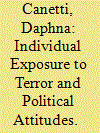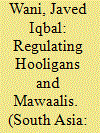| Srl | Item |
| 1 |
ID:
183004


|
|
|
|
|
| Summary/Abstract |
How does exposure to terrorism affect political attitudes? This paper presents a new individual-level psychobiological model of political attitudes. Using a unique individual-level data of personal exposure to terrorism, a physiological marker of inflammation (CRP) and a psychological measure of perception of threat to an ongoing conflict—the Israel-Palestinian Conflict—we assess the effect of personal exposure to terrorism on militant attitudes concerning the conflict. Our data of physiological (blood samples), psychological, and attitudinal factors were collected in Israel during a military escalation along the Gaza Strip border. The findings reveal that among people personally exposed to terrorism, the perception of threat mediates an association between physiological conditions and militant attitudes. These findings contribute to the emerging literature on the biopolitics of political violence, suggesting a renewed focus on the dynamic interplay between physiological, psychological, and political factors.
|
|
|
|
|
|
|
|
|
|
|
|
|
|
|
|
| 2 |
ID:
184785


|
|
|
|
|
| Summary/Abstract |
In 1938, a communal conflict took place in the city of Bombay. This confrontation between Hindus and Muslims flared into large-scale violence. During the riots, the home minister of the provincial government invoked a combination of laws such as Section 144 of the Code of Criminal Procedure and instituted curfews to control the situation. As a result, hundreds of inhabitants of the city were arrested. The purpose of this article is threefold. Firstly, it will highlight how communal conflict in the late colonial period would often begin over trivial issues but could easily expand into large-scale riots influenced by metapolitical concerns. Secondly, moments of ‘disorder’ facilitated the administrative urge to institute extraordinary laws like Section 144 and curfews. And thirdly, the invocation of extraordinary laws was justified in reference to various problem categories like mawaalis and hooligans in this case. Overall, the article will show that the provincial government led by Indians continued the colonial art of governance by resorting to repression as a significant tool to deal with political unrest.
|
|
|
|
|
|
|
|
|
|
|
|
|
|
|
|